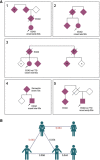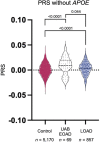Contributions of rare and common variation to early-onset and atypical dementia risk
- PMID: 37308299
- PMCID: PMC10393188
- DOI: 10.1101/mcs.a006271
Contributions of rare and common variation to early-onset and atypical dementia risk
Abstract
We collected and analyzed genomic sequencing data from individuals with clinician-diagnosed early-onset or atypical dementia. Thirty-two patients were previously described, with 68 newly described in this report. Of those 68, 62 patients self-reported white, non-Hispanic ethnicity and 6 reported as African-American, non-Hispanic. Fifty-three percent of patients had a returnable variant. Five patients harbored a pathogenic variant as defined by the American College of Medical Genetics criteria for pathogenicity. A polygenic risk score (PRS) was calculated for Alzheimer's patients in the total cohort and compared to the scores of a late-onset Alzheimer's cohort and a control set. Patients with early-onset Alzheimer's had higher non-APOE PRSs than patients with late-onset Alzheimer's, supporting the conclusion that both rare and common genetic variation associate with early-onset neurodegenerative disease risk.
Keywords: Alzheimer disease; frontotemporal dementia.
© 2023 Wright et al.; Published by Cold Spring Harbor Laboratory Press.
Figures



Update of
-
Contributions of rare and common variation to early-onset and atypical dementia risk.medRxiv [Preprint]. 2023 Feb 8:2023.02.06.23285383. doi: 10.1101/2023.02.06.23285383. medRxiv. 2023. Update in: Cold Spring Harb Mol Case Stud. 2023 Jul 11;9(3):a006271. doi: 10.1101/mcs.a006271. PMID: 36798301 Free PMC article. Updated. Preprint.
Similar articles
-
Contributions of rare and common variation to early-onset and atypical dementia risk.medRxiv [Preprint]. 2023 Feb 8:2023.02.06.23285383. doi: 10.1101/2023.02.06.23285383. medRxiv. 2023. Update in: Cold Spring Harb Mol Case Stud. 2023 Jul 11;9(3):a006271. doi: 10.1101/mcs.a006271. PMID: 36798301 Free PMC article. Updated. Preprint.
-
Mapping the genetic landscape of early-onset Alzheimer's disease in a cohort of 36 families.Alzheimers Res Ther. 2022 Jun 1;14(1):77. doi: 10.1186/s13195-022-01018-3. Alzheimers Res Ther. 2022. PMID: 35650585 Free PMC article.
-
Polygenic risk of Alzheimer's disease in the Faroe Islands.Eur J Neurol. 2022 Aug;29(8):2192-2200. doi: 10.1111/ene.15351. Epub 2022 Apr 19. Eur J Neurol. 2022. PMID: 35384166
-
Genetics of Alzheimer's disease in Caribbean Hispanic and African American populations.Biol Psychiatry. 2014 Apr 1;75(7):534-41. doi: 10.1016/j.biopsych.2013.06.003. Epub 2013 Jul 25. Biol Psychiatry. 2014. PMID: 23890735 Free PMC article. Review.
-
Clinical implications of APOE genotyping for late-onset Alzheimer's disease (LOAD) risk estimation: a review of the literature.J Neural Transm (Vienna). 2019 Jan;126(1):65-85. doi: 10.1007/s00702-018-1934-9. Epub 2018 Oct 31. J Neural Transm (Vienna). 2019. PMID: 30382407
Cited by
-
A Novel Rare PSEN2 Val226Ala in PSEN2 in a Korean Patient with Atypical Alzheimer's Disease, and the Importance of PSEN2 5th Transmembrane Domain (TM5) in AD Pathogenesis.Int J Mol Sci. 2024 Sep 6;25(17):9678. doi: 10.3390/ijms25179678. Int J Mol Sci. 2024. PMID: 39273625 Free PMC article.
-
Early-onset Alzheimer's disease explained by polygenic risk of late-onset disease?Alzheimers Dement (Amst). 2023 Sep 28;15(4):e12482. doi: 10.1002/dad2.12482. eCollection 2023 Oct-Dec. Alzheimers Dement (Amst). 2023. PMID: 37780862 Free PMC article.
References
Publication types
MeSH terms
Substances
Grants and funding
LinkOut - more resources
Full Text Sources
Medical
Miscellaneous
